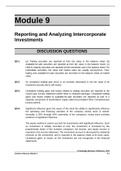Exam (elaborations)
ACG - Module 9: Reporting and Analyzing Intercorporate Investments. Questions and Answers.
- Course
- Institution
ACG - Module 9: Reporting and Analyzing Intercorporate Investments. Questions and Answers. Module 9 Reporting and Analyzing Intercorporate Investments DISCUSSION QUESTIONS Q9-1. (a) Trading securities are reported at their fair value in the balance sheet. (b) Available-for-sale securities ...
[Show more]



